Computational tools¶
Statistical Functions¶
Percent Change¶
Series, DataFrame, and Panel all have a method
pct_change() to compute the percent change over a given number
of periods (using fill_method to fill NA/null values before computing
the percent change).
In [1]: ser = pd.Series(np.random.randn(8))
In [2]: ser.pct_change()
Out[2]:
0 NaN
1 -1.602976
2 4.334938
3 -0.247456
4 -2.067345
5 -1.142903
6 -1.688214
7 -9.759729
dtype: float64
In [3]: df = pd.DataFrame(np.random.randn(10, 4))
In [4]: df.pct_change(periods=3)
Out[4]:
0 1 2 3
0 NaN NaN NaN NaN
1 NaN NaN NaN NaN
2 NaN NaN NaN NaN
3 -0.218320 -1.054001 1.987147 -0.510183
4 -0.439121 -1.816454 0.649715 -4.822809
5 -0.127833 -3.042065 -5.866604 -1.776977
6 -2.596833 -1.959538 -2.111697 -3.798900
7 -0.117826 -2.169058 0.036094 -0.067696
8 2.492606 -1.357320 -1.205802 -1.558697
9 -1.012977 2.324558 -1.003744 -0.371806
Covariance¶
Series.cov() can be used to compute covariance between series
(excluding missing values).
In [5]: s1 = pd.Series(np.random.randn(1000))
In [6]: s2 = pd.Series(np.random.randn(1000))
In [7]: s1.cov(s2)
Out[7]: 0.00068010881743110871
Analogously, DataFrame.cov() to compute pairwise covariances among the
series in the DataFrame, also excluding NA/null values.
Note
Assuming the missing data are missing at random this results in an estimate for the covariance matrix which is unbiased. However, for many applications this estimate may not be acceptable because the estimated covariance matrix is not guaranteed to be positive semi-definite. This could lead to estimated correlations having absolute values which are greater than one, and/or a non-invertible covariance matrix. See Estimation of covariance matrices for more details.
In [8]: frame = pd.DataFrame(np.random.randn(1000, 5), columns=['a', 'b', 'c', 'd', 'e'])
In [9]: frame.cov()
Out[9]:
a b c d e
a 1.000882 -0.003177 -0.002698 -0.006889 0.031912
b -0.003177 1.024721 0.000191 0.009212 0.000857
c -0.002698 0.000191 0.950735 -0.031743 -0.005087
d -0.006889 0.009212 -0.031743 1.002983 -0.047952
e 0.031912 0.000857 -0.005087 -0.047952 1.042487
DataFrame.cov also supports an optional min_periods keyword that
specifies the required minimum number of observations for each column pair
in order to have a valid result.
In [10]: frame = pd.DataFrame(np.random.randn(20, 3), columns=['a', 'b', 'c'])
In [11]: frame.loc[frame.index[:5], 'a'] = np.nan
In [12]: frame.loc[frame.index[5:10], 'b'] = np.nan
In [13]: frame.cov()
Out[13]:
a b c
a 1.123670 -0.412851 0.018169
b -0.412851 1.154141 0.305260
c 0.018169 0.305260 1.301149
In [14]: frame.cov(min_periods=12)
������������������������������������������������������������������������������������������������������������������������������������������Out[14]:
a b c
a 1.123670 NaN 0.018169
b NaN 1.154141 0.305260
c 0.018169 0.305260 1.301149
Correlation¶
Correlation may be computed using the corr() method.
Using the method parameter, several methods for computing correlations are
provided:
| Method name | Description |
|---|---|
pearson (default) |
Standard correlation coefficient |
kendall |
Kendall Tau correlation coefficient |
spearman |
Spearman rank correlation coefficient |
All of these are currently computed using pairwise complete observations. Wikipedia has articles covering the above correlation coefficients:
- Pearson correlation coefficient
- Kendall rank correlation coefficient
- Spearman’s rank correlation coefficient
Note
Please see the caveats associated with this method of calculating correlation matrices in the covariance section.
In [15]: frame = pd.DataFrame(np.random.randn(1000, 5), columns=['a', 'b', 'c', 'd', 'e'])
In [16]: frame.iloc[::2] = np.nan
# Series with Series
In [17]: frame['a'].corr(frame['b'])
Out[17]: 0.013479040400098794
In [18]: frame['a'].corr(frame['b'], method='spearman')
������������������������������Out[18]: -0.0072898851595406371
# Pairwise correlation of DataFrame columns
In [19]: frame.corr()
��������������������������������������������������������������Out[19]:
a b c d e
a 1.000000 0.013479 -0.049269 -0.042239 -0.028525
b 0.013479 1.000000 -0.020433 -0.011139 0.005654
c -0.049269 -0.020433 1.000000 0.018587 -0.054269
d -0.042239 -0.011139 0.018587 1.000000 -0.017060
e -0.028525 0.005654 -0.054269 -0.017060 1.000000
Note that non-numeric columns will be automatically excluded from the correlation calculation.
Like cov, corr also supports the optional min_periods keyword:
In [20]: frame = pd.DataFrame(np.random.randn(20, 3), columns=['a', 'b', 'c'])
In [21]: frame.loc[frame.index[:5], 'a'] = np.nan
In [22]: frame.loc[frame.index[5:10], 'b'] = np.nan
In [23]: frame.corr()
Out[23]:
a b c
a 1.000000 -0.121111 0.069544
b -0.121111 1.000000 0.051742
c 0.069544 0.051742 1.000000
In [24]: frame.corr(min_periods=12)
������������������������������������������������������������������������������������������������������������������������������������������Out[24]:
a b c
a 1.000000 NaN 0.069544
b NaN 1.000000 0.051742
c 0.069544 0.051742 1.000000
A related method corrwith() is implemented on DataFrame to
compute the correlation between like-labeled Series contained in different
DataFrame objects.
In [25]: index = ['a', 'b', 'c', 'd', 'e']
In [26]: columns = ['one', 'two', 'three', 'four']
In [27]: df1 = pd.DataFrame(np.random.randn(5, 4), index=index, columns=columns)
In [28]: df2 = pd.DataFrame(np.random.randn(4, 4), index=index[:4], columns=columns)
In [29]: df1.corrwith(df2)
Out[29]:
one -0.125501
two -0.493244
three 0.344056
four 0.004183
dtype: float64
In [30]: df2.corrwith(df1, axis=1)
�������������������������������������������������������������������������������������������������Out[30]:
a -0.675817
b 0.458296
c 0.190809
d -0.186275
e NaN
dtype: float64
Data ranking¶
The rank() method produces a data ranking with ties being
assigned the mean of the ranks (by default) for the group:
In [31]: s = pd.Series(np.random.np.random.randn(5), index=list('abcde'))
In [32]: s['d'] = s['b'] # so there's a tie
In [33]: s.rank()
Out[33]:
a 5.0
b 2.5
c 1.0
d 2.5
e 4.0
dtype: float64
rank() is also a DataFrame method and can rank either the rows
(axis=0) or the columns (axis=1). NaN values are excluded from the
ranking.
In [34]: df = pd.DataFrame(np.random.np.random.randn(10, 6))
In [35]: df[4] = df[2][:5] # some ties
In [36]: df
Out[36]:
0 1 2 3 4 5
0 -0.904948 -1.163537 -1.457187 0.135463 -1.457187 0.294650
1 -0.976288 -0.244652 -0.748406 -0.999601 -0.748406 -0.800809
2 0.401965 1.460840 1.256057 1.308127 1.256057 0.876004
3 0.205954 0.369552 -0.669304 0.038378 -0.669304 1.140296
4 -0.477586 -0.730705 -1.129149 -0.601463 -1.129149 -0.211196
5 -1.092970 -0.689246 0.908114 0.204848 NaN 0.463347
6 0.376892 0.959292 0.095572 -0.593740 NaN -0.069180
7 -1.002601 1.957794 -0.120708 0.094214 NaN -1.467422
8 -0.547231 0.664402 -0.519424 -0.073254 NaN -1.263544
9 -0.250277 -0.237428 -1.056443 0.419477 NaN 1.375064
In [37]: df.rank(1)
��������������������������������������������������������������������������������������������������������������������������������������������������������������������������������������������������������������������������������������������������������������������������������������������������������������������������������������������������������������������������������������������������������������������������������������������������������������������������������������������������������������������������������������������������������������������������������������������������������������������������������������������������������������������������������������������������������������������Out[37]:
0 1 2 3 4 5
0 4.0 3.0 1.5 5.0 1.5 6.0
1 2.0 6.0 4.5 1.0 4.5 3.0
2 1.0 6.0 3.5 5.0 3.5 2.0
3 4.0 5.0 1.5 3.0 1.5 6.0
4 5.0 3.0 1.5 4.0 1.5 6.0
5 1.0 2.0 5.0 3.0 NaN 4.0
6 4.0 5.0 3.0 1.0 NaN 2.0
7 2.0 5.0 3.0 4.0 NaN 1.0
8 2.0 5.0 3.0 4.0 NaN 1.0
9 2.0 3.0 1.0 4.0 NaN 5.0
rank optionally takes a parameter ascending which by default is true;
when false, data is reverse-ranked, with larger values assigned a smaller rank.
rank supports different tie-breaking methods, specified with the method
parameter:
average: average rank of tied groupmin: lowest rank in the groupmax: highest rank in the groupfirst: ranks assigned in the order they appear in the array
Window Functions¶
For working with data, a number of window functions are provided for computing common window or rolling statistics. Among these are count, sum, mean, median, correlation, variance, covariance, standard deviation, skewness, and kurtosis.
The rolling() and expanding()
functions can be used directly from DataFrameGroupBy objects,
see the groupby docs.
Note
The API for window statistics is quite similar to the way one works with GroupBy objects, see the documentation here.
We work with rolling, expanding and exponentially weighted data through the corresponding
objects, Rolling, Expanding and EWM.
In [38]: s = pd.Series(np.random.randn(1000), index=pd.date_range('1/1/2000', periods=1000))
In [39]: s = s.cumsum()
In [40]: s
Out[40]:
2000-01-01 -0.268824
2000-01-02 -1.771855
2000-01-03 -0.818003
2000-01-04 -0.659244
2000-01-05 -1.942133
2000-01-06 -1.869391
2000-01-07 0.563674
...
2002-09-20 -68.233054
2002-09-21 -66.765687
2002-09-22 -67.457323
2002-09-23 -69.253182
2002-09-24 -70.296818
2002-09-25 -70.844674
2002-09-26 -72.475016
Freq: D, Length: 1000, dtype: float64
These are created from methods on Series and DataFrame.
In [41]: r = s.rolling(window=60)
In [42]: r
Out[42]: Rolling [window=60,center=False,axis=0]
These object provide tab-completion of the available methods and properties.
In [14]: r.
r.agg r.apply r.count r.exclusions r.max r.median r.name r.skew r.sum
r.aggregate r.corr r.cov r.kurt r.mean r.min r.quantile r.std r.var
Generally these methods all have the same interface. They all accept the following arguments:
window: size of moving windowmin_periods: threshold of non-null data points to require (otherwise result is NA)center: boolean, whether to set the labels at the center (default is False)
We can then call methods on these rolling objects. These return like-indexed objects:
In [43]: r.mean()
Out[43]:
2000-01-01 NaN
2000-01-02 NaN
2000-01-03 NaN
2000-01-04 NaN
2000-01-05 NaN
2000-01-06 NaN
2000-01-07 NaN
...
2002-09-20 -62.694135
2002-09-21 -62.812190
2002-09-22 -62.914971
2002-09-23 -63.061867
2002-09-24 -63.213876
2002-09-25 -63.375074
2002-09-26 -63.539734
Freq: D, Length: 1000, dtype: float64
In [44]: s.plot(style='k--')
Out[44]: <matplotlib.axes._subplots.AxesSubplot at 0x1a28c48a90>
In [45]: r.mean().plot(style='k')
�����������������������������������������������������������������Out[45]: <matplotlib.axes._subplots.AxesSubplot at 0x1a28c48a90>
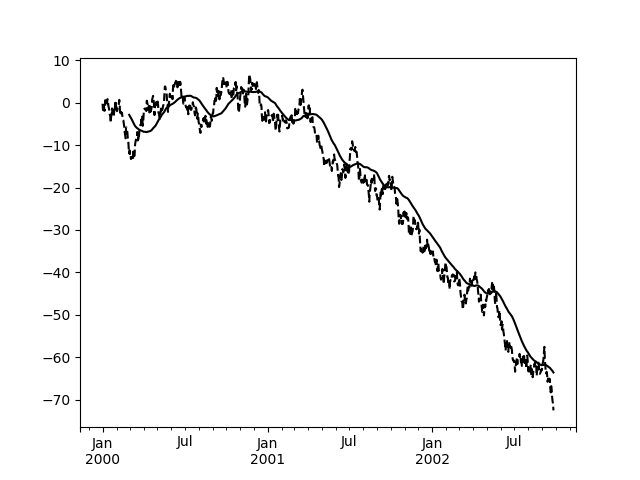
They can also be applied to DataFrame objects. This is really just syntactic sugar for applying the moving window operator to all of the DataFrame’s columns:
In [46]: df = pd.DataFrame(np.random.randn(1000, 4),
....: index=pd.date_range('1/1/2000', periods=1000),
....: columns=['A', 'B', 'C', 'D'])
....:
In [47]: df = df.cumsum()
In [48]: df.rolling(window=60).sum().plot(subplots=True)
Out[48]:
array([<matplotlib.axes._subplots.AxesSubplot object at 0x1a28d30588>,
<matplotlib.axes._subplots.AxesSubplot object at 0x1a28d563c8>,
<matplotlib.axes._subplots.AxesSubplot object at 0x1a28d7e588>,
<matplotlib.axes._subplots.AxesSubplot object at 0x1a28da7748>], dtype=object)
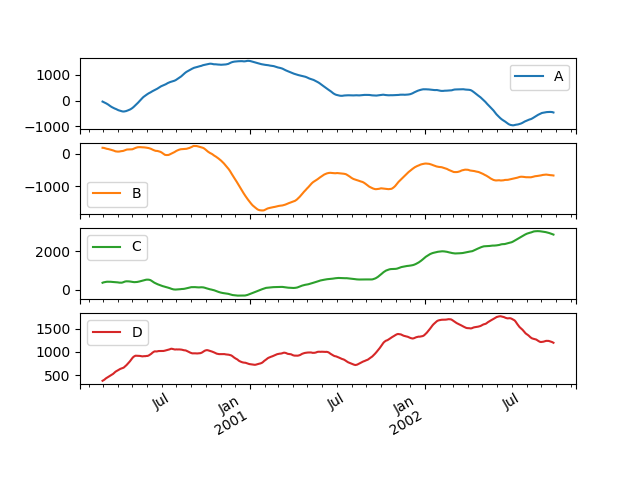
Method Summary¶
We provide a number of common statistical functions:
| Method | Description |
|---|---|
count() |
Number of non-null observations |
sum() |
Sum of values |
mean() |
Mean of values |
median() |
Arithmetic median of values |
min() |
Minimum |
max() |
Maximum |
std() |
Bessel-corrected sample standard deviation |
var() |
Unbiased variance |
skew() |
Sample skewness (3rd moment) |
kurt() |
Sample kurtosis (4th moment) |
quantile() |
Sample quantile (value at %) |
apply() |
Generic apply |
cov() |
Unbiased covariance (binary) |
corr() |
Correlation (binary) |
The apply() function takes an extra func argument and performs
generic rolling computations. The func argument should be a single function
that produces a single value from an ndarray input. Suppose we wanted to
compute the mean absolute deviation on a rolling basis:
In [49]: mad = lambda x: np.fabs(x - x.mean()).mean()
In [50]: s.rolling(window=60).apply(mad, raw=True).plot(style='k')
Out[50]: <matplotlib.axes._subplots.AxesSubplot at 0x1a28db80f0>
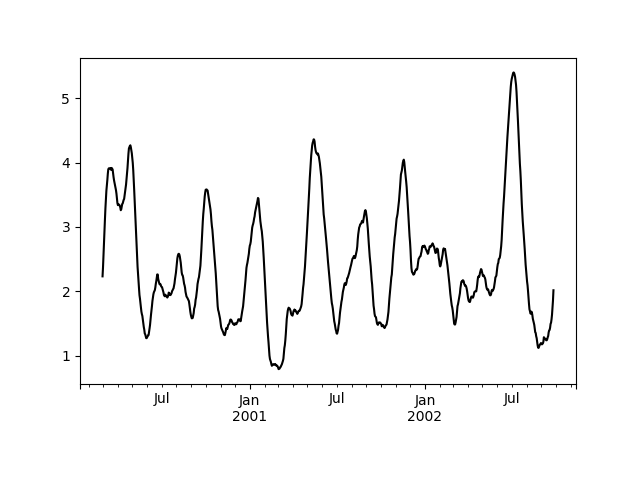
Rolling Windows¶
Passing win_type to .rolling generates a generic rolling window computation, that is weighted according the win_type.
The following methods are available:
| Method | Description |
|---|---|
sum() |
Sum of values |
mean() |
Mean of values |
The weights used in the window are specified by the win_type keyword.
The list of recognized types are the scipy.signal window functions:
boxcartriangblackmanhammingbartlettparzenbohmanblackmanharrisnuttallbarthannkaiser(needs beta)gaussian(needs std)general_gaussian(needs power, width)slepian(needs width).
In [51]: ser = pd.Series(np.random.randn(10), index=pd.date_range('1/1/2000', periods=10))
In [52]: ser.rolling(window=5, win_type='triang').mean()
Out[52]:
2000-01-01 NaN
2000-01-02 NaN
2000-01-03 NaN
2000-01-04 NaN
2000-01-05 -1.037870
2000-01-06 -0.767705
2000-01-07 -0.383197
2000-01-08 -0.395513
2000-01-09 -0.558440
2000-01-10 -0.672416
Freq: D, dtype: float64
Note that the boxcar window is equivalent to mean().
In [53]: ser.rolling(window=5, win_type='boxcar').mean()
Out[53]:
2000-01-01 NaN
2000-01-02 NaN
2000-01-03 NaN
2000-01-04 NaN
2000-01-05 -0.841164
2000-01-06 -0.779948
2000-01-07 -0.565487
2000-01-08 -0.502815
2000-01-09 -0.553755
2000-01-10 -0.472211
Freq: D, dtype: float64
In [54]: ser.rolling(window=5).mean()
������������������������������������������������������������������������������������������������������������������������������������������������������������������������������������������������������������������������������������������������������������������������Out[54]:
2000-01-01 NaN
2000-01-02 NaN
2000-01-03 NaN
2000-01-04 NaN
2000-01-05 -0.841164
2000-01-06 -0.779948
2000-01-07 -0.565487
2000-01-08 -0.502815
2000-01-09 -0.553755
2000-01-10 -0.472211
Freq: D, dtype: float64
For some windowing functions, additional parameters must be specified:
In [55]: ser.rolling(window=5, win_type='gaussian').mean(std=0.1)
Out[55]:
2000-01-01 NaN
2000-01-02 NaN
2000-01-03 NaN
2000-01-04 NaN
2000-01-05 -1.309989
2000-01-06 -1.153000
2000-01-07 0.606382
2000-01-08 -0.681101
2000-01-09 -0.289724
2000-01-10 -0.996632
Freq: D, dtype: float64
Note
For .sum() with a win_type, there is no normalization done to the
weights for the window. Passing custom weights of [1, 1, 1] will yield a different
result than passing weights of [2, 2, 2], for example. When passing a
win_type instead of explicitly specifying the weights, the weights are
already normalized so that the largest weight is 1.
In contrast, the nature of the .mean() calculation is
such that the weights are normalized with respect to each other. Weights
of [1, 1, 1] and [2, 2, 2] yield the same result.
Time-aware Rolling¶
New in version 0.19.0.
New in version 0.19.0 are the ability to pass an offset (or convertible) to a .rolling() method and have it produce
variable sized windows based on the passed time window. For each time point, this includes all preceding values occurring
within the indicated time delta.
This can be particularly useful for a non-regular time frequency index.
In [56]: dft = pd.DataFrame({'B': [0, 1, 2, np.nan, 4]},
....: index=pd.date_range('20130101 09:00:00', periods=5, freq='s'))
....:
In [57]: dft
Out[57]:
B
2013-01-01 09:00:00 0.0
2013-01-01 09:00:01 1.0
2013-01-01 09:00:02 2.0
2013-01-01 09:00:03 NaN
2013-01-01 09:00:04 4.0
This is a regular frequency index. Using an integer window parameter works to roll along the window frequency.
In [58]: dft.rolling(2).sum()
Out[58]:
B
2013-01-01 09:00:00 NaN
2013-01-01 09:00:01 1.0
2013-01-01 09:00:02 3.0
2013-01-01 09:00:03 NaN
2013-01-01 09:00:04 NaN
In [59]: dft.rolling(2, min_periods=1).sum()
����������������������������������������������������������������������������������������������������������������������������������������������������������������Out[59]:
B
2013-01-01 09:00:00 0.0
2013-01-01 09:00:01 1.0
2013-01-01 09:00:02 3.0
2013-01-01 09:00:03 2.0
2013-01-01 09:00:04 4.0
Specifying an offset allows a more intuitive specification of the rolling frequency.
In [60]: dft.rolling('2s').sum()
Out[60]:
B
2013-01-01 09:00:00 0.0
2013-01-01 09:00:01 1.0
2013-01-01 09:00:02 3.0
2013-01-01 09:00:03 2.0
2013-01-01 09:00:04 4.0
Using a non-regular, but still monotonic index, rolling with an integer window does not impart any special calculation.
In [61]: dft = pd.DataFrame({'B': [0, 1, 2, np.nan, 4]},
....: index = pd.Index([pd.Timestamp('20130101 09:00:00'),
....: pd.Timestamp('20130101 09:00:02'),
....: pd.Timestamp('20130101 09:00:03'),
....: pd.Timestamp('20130101 09:00:05'),
....: pd.Timestamp('20130101 09:00:06')],
....: name='foo'))
....:
In [62]: dft
Out[62]:
B
foo
2013-01-01 09:00:00 0.0
2013-01-01 09:00:02 1.0
2013-01-01 09:00:03 2.0
2013-01-01 09:00:05 NaN
2013-01-01 09:00:06 4.0
In [63]: dft.rolling(2).sum()
�����������������������������������������������������������������������������������������������������������������������������������������������������������������������������������������Out[63]:
B
foo
2013-01-01 09:00:00 NaN
2013-01-01 09:00:02 1.0
2013-01-01 09:00:03 3.0
2013-01-01 09:00:05 NaN
2013-01-01 09:00:06 NaN
Using the time-specification generates variable windows for this sparse data.
In [64]: dft.rolling('2s').sum()
Out[64]:
B
foo
2013-01-01 09:00:00 0.0
2013-01-01 09:00:02 1.0
2013-01-01 09:00:03 3.0
2013-01-01 09:00:05 NaN
2013-01-01 09:00:06 4.0
Furthermore, we now allow an optional on parameter to specify a column (rather than the
default of the index) in a DataFrame.
In [65]: dft = dft.reset_index()
In [66]: dft
Out[66]:
foo B
0 2013-01-01 09:00:00 0.0
1 2013-01-01 09:00:02 1.0
2 2013-01-01 09:00:03 2.0
3 2013-01-01 09:00:05 NaN
4 2013-01-01 09:00:06 4.0
In [67]: dft.rolling('2s', on='foo').sum()
����������������������������������������������������������������������������������������������������������������������������������������������������������������������������Out[67]:
foo B
0 2013-01-01 09:00:00 0.0
1 2013-01-01 09:00:02 1.0
2 2013-01-01 09:00:03 3.0
3 2013-01-01 09:00:05 NaN
4 2013-01-01 09:00:06 4.0
Rolling Window Endpoints¶
New in version 0.20.0.
The inclusion of the interval endpoints in rolling window calculations can be specified with the closed
parameter:
closed |
Description | Default for |
|---|---|---|
right |
close right endpoint | time-based windows |
left |
close left endpoint | |
both |
close both endpoints | fixed windows |
neither |
open endpoints |
For example, having the right endpoint open is useful in many problems that require that there is no contamination from present information back to past information. This allows the rolling window to compute statistics “up to that point in time”, but not including that point in time.
In [68]: df = pd.DataFrame({'x': 1},
....: index = [pd.Timestamp('20130101 09:00:01'),
....: pd.Timestamp('20130101 09:00:02'),
....: pd.Timestamp('20130101 09:00:03'),
....: pd.Timestamp('20130101 09:00:04'),
....: pd.Timestamp('20130101 09:00:06')])
....:
In [69]: df["right"] = df.rolling('2s', closed='right').x.sum() # default
In [70]: df["both"] = df.rolling('2s', closed='both').x.sum()
In [71]: df["left"] = df.rolling('2s', closed='left').x.sum()
In [72]: df["neither"] = df.rolling('2s', closed='neither').x.sum()
In [73]: df
Out[73]:
x right both left neither
2013-01-01 09:00:01 1 1.0 1.0 NaN NaN
2013-01-01 09:00:02 1 2.0 2.0 1.0 1.0
2013-01-01 09:00:03 1 2.0 3.0 2.0 1.0
2013-01-01 09:00:04 1 2.0 3.0 2.0 1.0
2013-01-01 09:00:06 1 1.0 2.0 1.0 NaN
Currently, this feature is only implemented for time-based windows. For fixed windows, the closed parameter cannot be set and the rolling window will always have both endpoints closed.
Time-aware Rolling vs. Resampling¶
Using .rolling() with a time-based index is quite similar to resampling. They
both operate and perform reductive operations on time-indexed pandas objects.
When using .rolling() with an offset. The offset is a time-delta. Take a backwards-in-time looking window, and
aggregate all of the values in that window (including the end-point, but not the start-point). This is the new value
at that point in the result. These are variable sized windows in time-space for each point of the input. You will get
a same sized result as the input.
When using .resample() with an offset. Construct a new index that is the frequency of the offset. For each frequency
bin, aggregate points from the input within a backwards-in-time looking window that fall in that bin. The result of this
aggregation is the output for that frequency point. The windows are fixed size in the frequency space. Your result
will have the shape of a regular frequency between the min and the max of the original input object.
To summarize, .rolling() is a time-based window operation, while .resample() is a frequency-based window operation.
Centering Windows¶
By default the labels are set to the right edge of the window, but a
center keyword is available so the labels can be set at the center.
In [74]: ser.rolling(window=5).mean()
Out[74]:
2000-01-01 NaN
2000-01-02 NaN
2000-01-03 NaN
2000-01-04 NaN
2000-01-05 -0.841164
2000-01-06 -0.779948
2000-01-07 -0.565487
2000-01-08 -0.502815
2000-01-09 -0.553755
2000-01-10 -0.472211
Freq: D, dtype: float64
In [75]: ser.rolling(window=5, center=True).mean()
������������������������������������������������������������������������������������������������������������������������������������������������������������������������������������������������������������������������������������������������������������������������Out[75]:
2000-01-01 NaN
2000-01-02 NaN
2000-01-03 -0.841164
2000-01-04 -0.779948
2000-01-05 -0.565487
2000-01-06 -0.502815
2000-01-07 -0.553755
2000-01-08 -0.472211
2000-01-09 NaN
2000-01-10 NaN
Freq: D, dtype: float64
Binary Window Functions¶
cov() and corr() can compute moving window statistics about
two Series or any combination of DataFrame/Series or
DataFrame/DataFrame. Here is the behavior in each case:
- two
Series: compute the statistic for the pairing. DataFrame/Series: compute the statistics for each column of the DataFrame with the passed Series, thus returning a DataFrame.DataFrame/DataFrame: by default compute the statistic for matching column names, returning a DataFrame. If the keyword argumentpairwise=Trueis passed then computes the statistic for each pair of columns, returning aMultiIndexed DataFramewhoseindexare the dates in question (see the next section).
For example:
In [76]: df = pd.DataFrame(np.random.randn(1000, 4),
....: index=pd.date_range('1/1/2000', periods=1000),
....: columns=['A', 'B', 'C', 'D'])
....:
In [77]: df = df.cumsum()
In [78]: df2 = df[:20]
In [79]: df2.rolling(window=5).corr(df2['B'])
Out[79]:
A B C D
2000-01-01 NaN NaN NaN NaN
2000-01-02 NaN NaN NaN NaN
2000-01-03 NaN NaN NaN NaN
2000-01-04 NaN NaN NaN NaN
2000-01-05 0.768775 1.0 -0.977990 0.800252
2000-01-06 0.744106 1.0 -0.967912 0.830021
2000-01-07 0.683257 1.0 -0.928969 0.384916
... ... ... ... ...
2000-01-14 -0.392318 1.0 0.570240 -0.591056
2000-01-15 0.017217 1.0 0.649900 -0.896258
2000-01-16 0.691078 1.0 0.807450 -0.939302
2000-01-17 0.274506 1.0 0.582601 -0.902954
2000-01-18 0.330459 1.0 0.515707 -0.545268
2000-01-19 0.046756 1.0 -0.104334 -0.419799
2000-01-20 -0.328241 1.0 -0.650974 -0.777777
[20 rows x 4 columns]
Computing rolling pairwise covariances and correlations¶
Warning
Prior to version 0.20.0 if pairwise=True was passed, a Panel would be returned.
This will now return a 2-level MultiIndexed DataFrame, see the whatsnew here.
In financial data analysis and other fields it’s common to compute covariance
and correlation matrices for a collection of time series. Often one is also
interested in moving-window covariance and correlation matrices. This can be
done by passing the pairwise keyword argument, which in the case of
DataFrame inputs will yield a MultiIndexed DataFrame whose index are the dates in
question. In the case of a single DataFrame argument the pairwise argument
can even be omitted:
Note
Missing values are ignored and each entry is computed using the pairwise complete observations. Please see the covariance section for caveats associated with this method of calculating covariance and correlation matrices.
In [80]: covs = df[['B','C','D']].rolling(window=50).cov(df[['A','B','C']], pairwise=True)
In [81]: covs.loc['2002-09-22':]
Out[81]:
B C D
2002-09-22 A 1.367467 8.676734 -8.047366
B 3.067315 0.865946 -1.052533
C 0.865946 7.739761 -4.943924
2002-09-23 A 0.910343 8.669065 -8.443062
B 2.625456 0.565152 -0.907654
C 0.565152 7.825521 -5.367526
2002-09-24 A 0.463332 8.514509 -8.776514
B 2.306695 0.267746 -0.732186
C 0.267746 7.771425 -5.696962
2002-09-25 A 0.467976 8.198236 -9.162599
B 2.307129 0.267287 -0.754080
C 0.267287 7.466559 -5.822650
2002-09-26 A 0.545781 7.899084 -9.326238
B 2.311058 0.322295 -0.844451
C 0.322295 7.038237 -5.684445
In [82]: correls = df.rolling(window=50).corr()
In [83]: correls.loc['2002-09-22':]
Out[83]:
A B C D
2002-09-22 A 1.000000 0.186397 0.744551 -0.769767
B 0.186397 1.000000 0.177725 -0.240802
C 0.744551 0.177725 1.000000 -0.712051
D -0.769767 -0.240802 -0.712051 1.000000
2002-09-23 A 1.000000 0.134723 0.743113 -0.758758
B 0.134723 1.000000 0.124683 -0.209934
C 0.743113 0.124683 1.000000 -0.719088
... ... ... ... ...
2002-09-25 B 0.075157 1.000000 0.064399 -0.164179
C 0.731888 0.064399 1.000000 -0.704686
D -0.739160 -0.164179 -0.704686 1.000000
2002-09-26 A 1.000000 0.087756 0.727792 -0.736562
B 0.087756 1.000000 0.079913 -0.179477
C 0.727792 0.079913 1.000000 -0.692303
D -0.736562 -0.179477 -0.692303 1.000000
[20 rows x 4 columns]
You can efficiently retrieve the time series of correlations between two columns by reshaping and indexing:
In [84]: correls.unstack(1)[('A', 'C')].plot()
Out[84]: <matplotlib.axes._subplots.AxesSubplot at 0x1c2985c6a0>
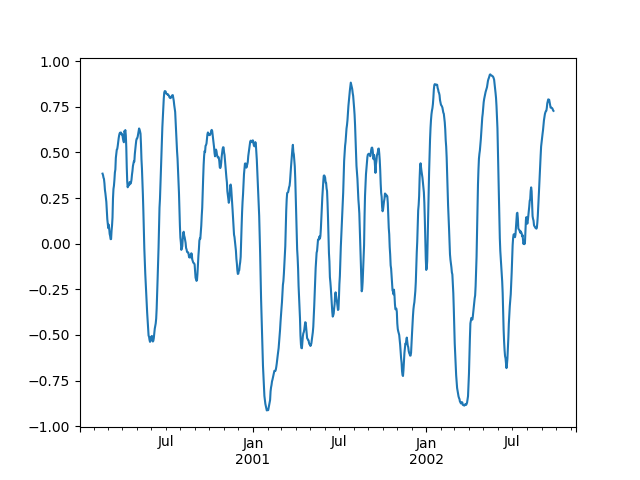
Aggregation¶
Once the Rolling, Expanding or EWM objects have been created, several methods are available to
perform multiple computations on the data. These operations are similar to the aggregating API,
groupby API, and resample API.
In [85]: dfa = pd.DataFrame(np.random.randn(1000, 3),
....: index=pd.date_range('1/1/2000', periods=1000),
....: columns=['A', 'B', 'C'])
....:
In [86]: r = dfa.rolling(window=60,min_periods=1)
In [87]: r
Out[87]: Rolling [window=60,min_periods=1,center=False,axis=0]
We can aggregate by passing a function to the entire DataFrame, or select a
Series (or multiple Series) via standard __getitem__.
In [88]: r.aggregate(np.sum)
Out[88]:
A B C
2000-01-01 -0.289838 -0.370545 -1.284206
2000-01-02 -0.216612 -1.675528 -1.169415
2000-01-03 1.154661 -1.634017 -1.566620
2000-01-04 2.969393 -4.003274 -1.816179
2000-01-05 4.690630 -4.682017 -2.717209
2000-01-06 3.880630 -4.447700 -1.078947
2000-01-07 4.001957 -2.884072 -3.116903
... ... ... ...
2002-09-20 2.652493 -10.528875 9.867805
2002-09-21 0.844497 -9.280944 9.522649
2002-09-22 2.860036 -9.270337 6.415245
2002-09-23 3.510163 -8.151439 5.177219
2002-09-24 6.524983 -10.168078 5.792639
2002-09-25 6.409626 -9.956226 5.704050
2002-09-26 5.093787 -7.074515 6.905823
[1000 rows x 3 columns]
In [89]: r['A'].aggregate(np.sum)
�����������������������������������������������������������������������������������������������������������������������������������������������������������������������������������������������������������������������������������������������������������������������������������������������������������������������������������������������������������������������������������������������������������������������������������������������������������������������������������������������������������������������������������������������������������������������������������������������������������������������������������������������������������������������������������������������������������������������������������Out[89]:
2000-01-01 -0.289838
2000-01-02 -0.216612
2000-01-03 1.154661
2000-01-04 2.969393
2000-01-05 4.690630
2000-01-06 3.880630
2000-01-07 4.001957
...
2002-09-20 2.652493
2002-09-21 0.844497
2002-09-22 2.860036
2002-09-23 3.510163
2002-09-24 6.524983
2002-09-25 6.409626
2002-09-26 5.093787
Freq: D, Name: A, Length: 1000, dtype: float64
In [90]: r[['A','B']].aggregate(np.sum)
�����������������������������������������������������������������������������������������������������������������������������������������������������������������������������������������������������������������������������������������������������������������������������������������������������������������������������������������������������������������������������������������������������������������������������������������������������������������������������������������������������������������������������������������������������������������������������������������������������������������������������������������������������������������������������������������������������������������������������������������������������������������������������������������������������������������������������������������������������������������������������������������������������������������������������������������������������������������������������������������������������������������������������������������������������������������������������������������������������������������������������������������������������Out[90]:
A B
2000-01-01 -0.289838 -0.370545
2000-01-02 -0.216612 -1.675528
2000-01-03 1.154661 -1.634017
2000-01-04 2.969393 -4.003274
2000-01-05 4.690630 -4.682017
2000-01-06 3.880630 -4.447700
2000-01-07 4.001957 -2.884072
... ... ...
2002-09-20 2.652493 -10.528875
2002-09-21 0.844497 -9.280944
2002-09-22 2.860036 -9.270337
2002-09-23 3.510163 -8.151439
2002-09-24 6.524983 -10.168078
2002-09-25 6.409626 -9.956226
2002-09-26 5.093787 -7.074515
[1000 rows x 2 columns]
As you can see, the result of the aggregation will have the selected columns, or all columns if none are selected.
Applying multiple functions¶
With windowed Series you can also pass a list of functions to do
aggregation with, outputting a DataFrame:
In [91]: r['A'].agg([np.sum, np.mean, np.std])
Out[91]:
sum mean std
2000-01-01 -0.289838 -0.289838 NaN
2000-01-02 -0.216612 -0.108306 0.256725
2000-01-03 1.154661 0.384887 0.873311
2000-01-04 2.969393 0.742348 1.009734
2000-01-05 4.690630 0.938126 0.977914
2000-01-06 3.880630 0.646772 1.128883
2000-01-07 4.001957 0.571708 1.049487
... ... ... ...
2002-09-20 2.652493 0.044208 1.164919
2002-09-21 0.844497 0.014075 1.148231
2002-09-22 2.860036 0.047667 1.132051
2002-09-23 3.510163 0.058503 1.134296
2002-09-24 6.524983 0.108750 1.144204
2002-09-25 6.409626 0.106827 1.142913
2002-09-26 5.093787 0.084896 1.151416
[1000 rows x 3 columns]
On a windowed DataFrame, you can pass a list of functions to apply to each column, which produces an aggregated result with a hierarchical index:
In [92]: r.agg([np.sum, np.mean])
Out[92]:
A B C
sum mean sum mean sum mean
2000-01-01 -0.289838 -0.289838 -0.370545 -0.370545 -1.284206 -1.284206
2000-01-02 -0.216612 -0.108306 -1.675528 -0.837764 -1.169415 -0.584708
2000-01-03 1.154661 0.384887 -1.634017 -0.544672 -1.566620 -0.522207
2000-01-04 2.969393 0.742348 -4.003274 -1.000819 -1.816179 -0.454045
2000-01-05 4.690630 0.938126 -4.682017 -0.936403 -2.717209 -0.543442
2000-01-06 3.880630 0.646772 -4.447700 -0.741283 -1.078947 -0.179825
2000-01-07 4.001957 0.571708 -2.884072 -0.412010 -3.116903 -0.445272
... ... ... ... ... ... ...
2002-09-20 2.652493 0.044208 -10.528875 -0.175481 9.867805 0.164463
2002-09-21 0.844497 0.014075 -9.280944 -0.154682 9.522649 0.158711
2002-09-22 2.860036 0.047667 -9.270337 -0.154506 6.415245 0.106921
2002-09-23 3.510163 0.058503 -8.151439 -0.135857 5.177219 0.086287
2002-09-24 6.524983 0.108750 -10.168078 -0.169468 5.792639 0.096544
2002-09-25 6.409626 0.106827 -9.956226 -0.165937 5.704050 0.095068
2002-09-26 5.093787 0.084896 -7.074515 -0.117909 6.905823 0.115097
[1000 rows x 6 columns]
Passing a dict of functions has different behavior by default, see the next section.
Applying different functions to DataFrame columns¶
By passing a dict to aggregate you can apply a different aggregation to the
columns of a DataFrame:
In [93]: r.agg({'A' : np.sum,
....: 'B' : lambda x: np.std(x, ddof=1)})
....:
Out[93]:
A B
2000-01-01 -0.289838 NaN
2000-01-02 -0.216612 0.660747
2000-01-03 1.154661 0.689929
2000-01-04 2.969393 1.072199
2000-01-05 4.690630 0.939657
2000-01-06 3.880630 0.966848
2000-01-07 4.001957 1.240137
... ... ...
2002-09-20 2.652493 1.114814
2002-09-21 0.844497 1.113220
2002-09-22 2.860036 1.113208
2002-09-23 3.510163 1.132381
2002-09-24 6.524983 1.080963
2002-09-25 6.409626 1.082911
2002-09-26 5.093787 1.136199
[1000 rows x 2 columns]
The function names can also be strings. In order for a string to be valid it must be implemented on the windowed object
In [94]: r.agg({'A' : 'sum', 'B' : 'std'})
Out[94]:
A B
2000-01-01 -0.289838 NaN
2000-01-02 -0.216612 0.660747
2000-01-03 1.154661 0.689929
2000-01-04 2.969393 1.072199
2000-01-05 4.690630 0.939657
2000-01-06 3.880630 0.966848
2000-01-07 4.001957 1.240137
... ... ...
2002-09-20 2.652493 1.114814
2002-09-21 0.844497 1.113220
2002-09-22 2.860036 1.113208
2002-09-23 3.510163 1.132381
2002-09-24 6.524983 1.080963
2002-09-25 6.409626 1.082911
2002-09-26 5.093787 1.136199
[1000 rows x 2 columns]
Furthermore you can pass a nested dict to indicate different aggregations on different columns.
In [95]: r.agg({'A' : ['sum','std'], 'B' : ['mean','std'] })
Out[95]:
A B
sum std mean std
2000-01-01 -0.289838 NaN -0.370545 NaN
2000-01-02 -0.216612 0.256725 -0.837764 0.660747
2000-01-03 1.154661 0.873311 -0.544672 0.689929
2000-01-04 2.969393 1.009734 -1.000819 1.072199
2000-01-05 4.690630 0.977914 -0.936403 0.939657
2000-01-06 3.880630 1.128883 -0.741283 0.966848
2000-01-07 4.001957 1.049487 -0.412010 1.240137
... ... ... ... ...
2002-09-20 2.652493 1.164919 -0.175481 1.114814
2002-09-21 0.844497 1.148231 -0.154682 1.113220
2002-09-22 2.860036 1.132051 -0.154506 1.113208
2002-09-23 3.510163 1.134296 -0.135857 1.132381
2002-09-24 6.524983 1.144204 -0.169468 1.080963
2002-09-25 6.409626 1.142913 -0.165937 1.082911
2002-09-26 5.093787 1.151416 -0.117909 1.136199
[1000 rows x 4 columns]
Expanding Windows¶
A common alternative to rolling statistics is to use an expanding window, which yields the value of the statistic with all the data available up to that point in time.
These follow a similar interface to .rolling, with the .expanding method
returning an Expanding object.
As these calculations are a special case of rolling statistics, they are implemented in pandas such that the following two calls are equivalent:
In [96]: df.rolling(window=len(df), min_periods=1).mean()[:5]
Out[96]:
A B C D
2000-01-01 0.314226 -0.001675 0.071823 0.892566
2000-01-02 0.654522 -0.171495 0.179278 0.853361
2000-01-03 0.708733 -0.064489 -0.238271 1.371111
2000-01-04 0.987613 0.163472 -0.919693 1.566485
2000-01-05 1.426971 0.288267 -1.358877 1.808650
In [97]: df.expanding(min_periods=1).mean()[:5]
����������������������������������������������������������������������������������������������������������������������������������������������������������������������������������������������������������������������������������������������������������������������������������������������������������������������������Out[97]:
A B C D
2000-01-01 0.314226 -0.001675 0.071823 0.892566
2000-01-02 0.654522 -0.171495 0.179278 0.853361
2000-01-03 0.708733 -0.064489 -0.238271 1.371111
2000-01-04 0.987613 0.163472 -0.919693 1.566485
2000-01-05 1.426971 0.288267 -1.358877 1.808650
These have a similar set of methods to .rolling methods.
Method Summary¶
| Function | Description |
|---|---|
count() |
Number of non-null observations |
sum() |
Sum of values |
mean() |
Mean of values |
median() |
Arithmetic median of values |
min() |
Minimum |
max() |
Maximum |
std() |
Unbiased standard deviation |
var() |
Unbiased variance |
skew() |
Unbiased skewness (3rd moment) |
kurt() |
Unbiased kurtosis (4th moment) |
quantile() |
Sample quantile (value at %) |
apply() |
Generic apply |
cov() |
Unbiased covariance (binary) |
corr() |
Correlation (binary) |
Aside from not having a window parameter, these functions have the same
interfaces as their .rolling counterparts. Like above, the parameters they
all accept are:
min_periods: threshold of non-null data points to require. Defaults to minimum needed to compute statistic. NoNaNswill be output oncemin_periodsnon-null data points have been seen.center: boolean, whether to set the labels at the center (default is False).
Note
The output of the .rolling and .expanding methods do not return a
NaN if there are at least min_periods non-null values in the current
window. For example:
In [98]: sn = pd.Series([1, 2, np.nan, 3, np.nan, 4])
In [99]: sn
Out[99]:
0 1.0
1 2.0
2 NaN
3 3.0
4 NaN
5 4.0
dtype: float64
In [100]: sn.rolling(2).max()
�������������������������������������������������������������������������������Out[100]:
0 NaN
1 2.0
2 NaN
3 NaN
4 NaN
5 NaN
dtype: float64
In [101]: sn.rolling(2, min_periods=1).max()
���������������������������������������������������������������������������������������������������������������������������������������������������������������Out[101]:
0 1.0
1 2.0
2 2.0
3 3.0
4 3.0
5 4.0
dtype: float64
In case of expanding functions, this differs from cumsum(),
cumprod(), cummax(),
and cummin(), which return NaN in the output wherever
a NaN is encountered in the input. In order to match the output of cumsum
with expanding, use fillna():
In [102]: sn.expanding().sum()
Out[102]:
0 1.0
1 3.0
2 3.0
3 6.0
4 6.0
5 10.0
dtype: float64
In [103]: sn.cumsum()
��������������������������������������������������������������������������������������Out[103]:
0 1.0
1 3.0
2 NaN
3 6.0
4 NaN
5 10.0
dtype: float64
In [104]: sn.cumsum().fillna(method='ffill')
����������������������������������������������������������������������������������������������������������������������������������������������������������������������������Out[104]:
0 1.0
1 3.0
2 3.0
3 6.0
4 6.0
5 10.0
dtype: float64
An expanding window statistic will be more stable (and less responsive) than
its rolling window counterpart as the increasing window size decreases the
relative impact of an individual data point. As an example, here is the
mean() output for the previous time series dataset:
In [105]: s.plot(style='k--')
Out[105]: <matplotlib.axes._subplots.AxesSubplot at 0x1c2988af28>
In [106]: s.expanding().mean().plot(style='k')
������������������������������������������������������������������Out[106]: <matplotlib.axes._subplots.AxesSubplot at 0x1c2988af28>
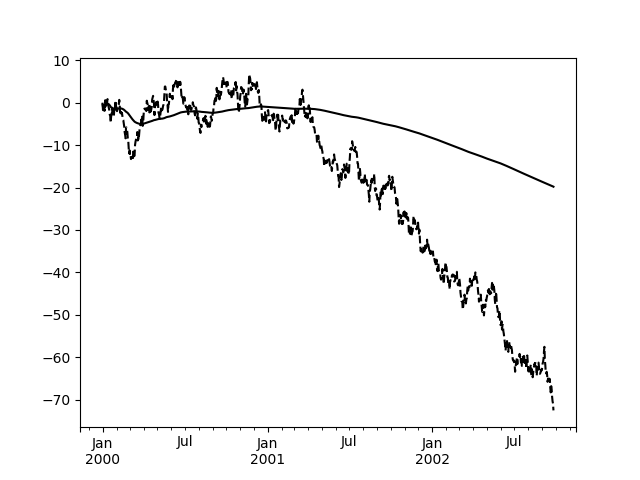
Exponentially Weighted Windows¶
A related set of functions are exponentially weighted versions of several of
the above statistics. A similar interface to .rolling and .expanding is accessed
through the .ewm method to receive an EWM object.
A number of expanding EW (exponentially weighted)
methods are provided:
| Function | Description |
|---|---|
mean() |
EW moving average |
var() |
EW moving variance |
std() |
EW moving standard deviation |
corr() |
EW moving correlation |
cov() |
EW moving covariance |
In general, a weighted moving average is calculated as
where \(x_t\) is the input, \(y_t\) is the result and the \(w_i\) are the weights.
The EW functions support two variants of exponential weights.
The default, adjust=True, uses the weights \(w_i = (1 - \alpha)^i\)
which gives
When adjust=False is specified, moving averages are calculated as
which is equivalent to using weights
Note
These equations are sometimes written in terms of \(\alpha' = 1 - \alpha\), e.g.
The difference between the above two variants arises because we are dealing with series which have finite history. Consider a series of infinite history:
Noting that the denominator is a geometric series with initial term equal to 1 and a ratio of \(1 - \alpha\) we have
which shows the equivalence of the above two variants for infinite series.
When adjust=True we have \(y_0 = x_0\) and from the last
representation above we have \(y_t = \alpha x_t + (1 - \alpha) y_{t-1}\),
therefore there is an assumption that \(x_0\) is not an ordinary value
but rather an exponentially weighted moment of the infinite series up to that
point.
One must have \(0 < \alpha \leq 1\), and while since version 0.18.0 it has been possible to pass \(\alpha\) directly, it’s often easier to think about either the span, center of mass (com) or half-life of an EW moment:
One must specify precisely one of span, center of mass, half-life and alpha to the EW functions:
- Span corresponds to what is commonly called an “N-day EW moving average”.
- Center of mass has a more physical interpretation and can be thought of in terms of span: \(c = (s - 1) / 2\).
- Half-life is the period of time for the exponential weight to reduce to one half.
- Alpha specifies the smoothing factor directly.
Here is an example for a univariate time series:
In [107]: s.plot(style='k--')
Out[107]: <matplotlib.axes._subplots.AxesSubplot at 0x1a286b5f28>
In [108]: s.ewm(span=20).mean().plot(style='k')
������������������������������������������������������������������Out[108]: <matplotlib.axes._subplots.AxesSubplot at 0x1a286b5f28>
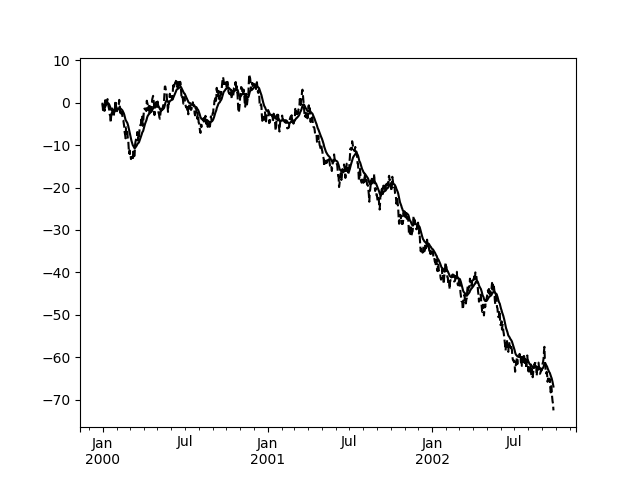
EWM has a min_periods argument, which has the same
meaning it does for all the .expanding and .rolling methods:
no output values will be set until at least min_periods non-null values
are encountered in the (expanding) window.
EWM also has an ignore_na argument, which determines how
intermediate null values affect the calculation of the weights.
When ignore_na=False (the default), weights are calculated based on absolute
positions, so that intermediate null values affect the result.
When ignore_na=True,
weights are calculated by ignoring intermediate null values.
For example, assuming adjust=True, if ignore_na=False, the weighted
average of 3, NaN, 5 would be calculated as
Whereas if ignore_na=True, the weighted average would be calculated as
The var(), std(), and cov() functions have a bias argument,
specifying whether the result should contain biased or unbiased statistics.
For example, if bias=True, ewmvar(x) is calculated as
ewmvar(x) = ewma(x**2) - ewma(x)**2;
whereas if bias=False (the default), the biased variance statistics
are scaled by debiasing factors
(For \(w_i = 1\), this reduces to the usual \(N / (N - 1)\) factor, with \(N = t + 1\).) See Weighted Sample Variance on Wikipedia for further details.